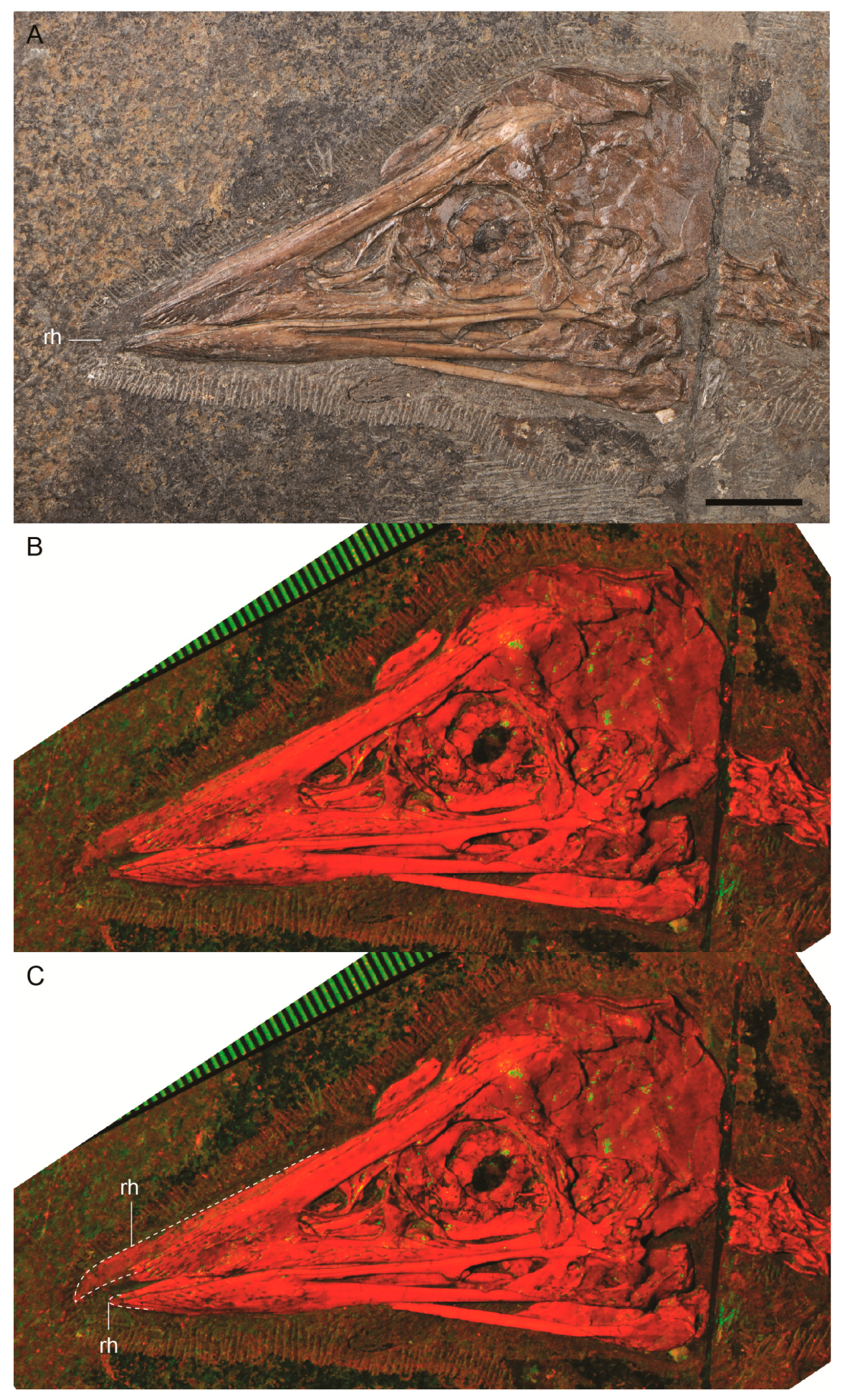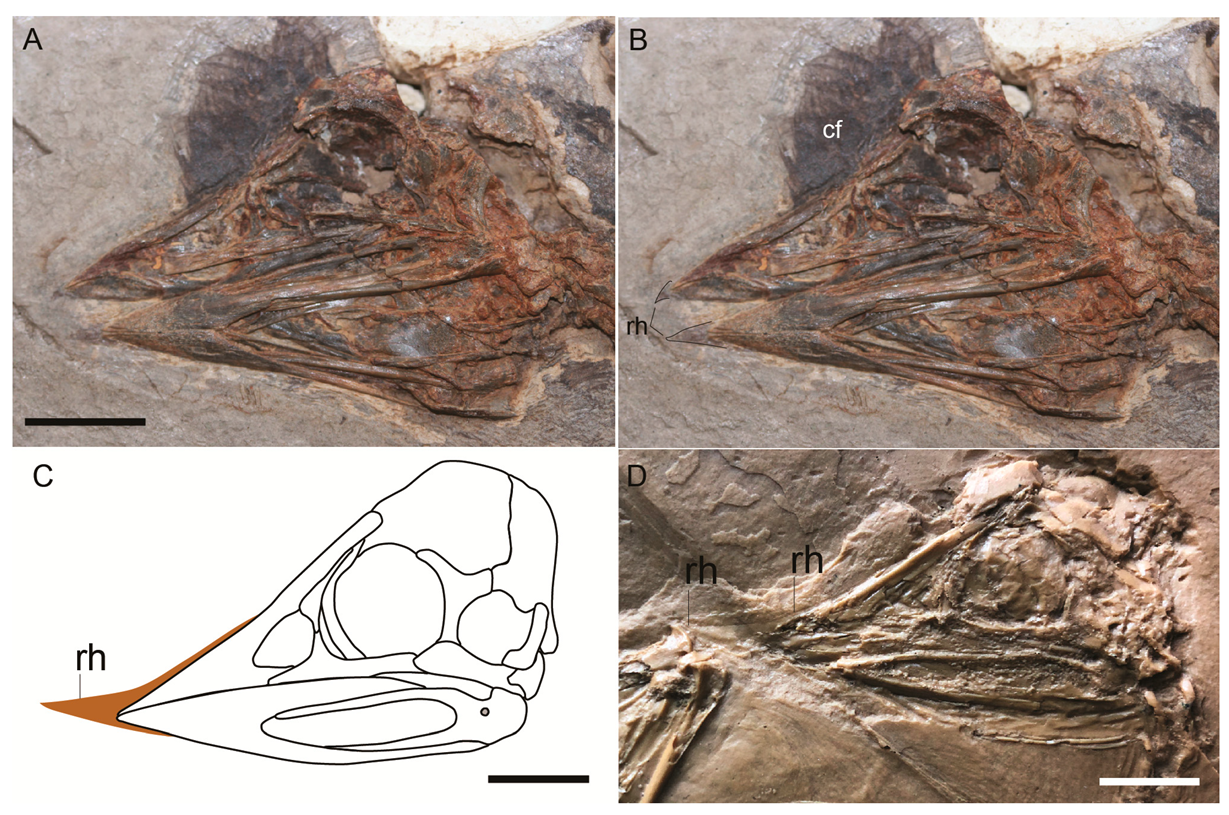On the Preservation of the Beak in Confuciusornis (Aves: Pygostylia)
Abstract
:1. Introduction
2. Materials and Methods
3. Results
4. Discussion
Author Contributions
Funding
Acknowledgments
Conflicts of Interest
References
- Bonser, R.H. Comparative mechanics of bill, claw and feather keratin in the Common Starling Sturnus vulgaris. J. Avian Biol. 1996, 27, 175–177. [Google Scholar] [CrossRef]
- Bright, J.A.; Marugán-Lobón, J.; Cobb, S.N.; Rayfield, E.J. The shapes of bird beaks are highly controlled by nondietary factors. Proc. Natl. Acad. Sci. USA 2016, 113, 5352–5357. [Google Scholar] [CrossRef] [PubMed]
- Brush, A.H.; Wyld, J.A. Molecular organization of avian epidermal structures. Comp. Biochem. Physiol. 1982, 73, 313–325. [Google Scholar] [CrossRef]
- Button, K.A. Soft Tissue Reconstruction and Ecomorphology of Beaks in Extant and Extinct Theropod Dinosaurs; North Carolina State University: Raleigh, NC, USA, 2018. [Google Scholar]
- Chiappe, L.M.; Ji, S.; Ji, Q.; Norell, M.A. Anatomy and systematics of the Confuciusornithidae (Theropoda: Aves) from the Late Mesozoic of northeastern China. Bull. Am. Mus. Nat. Hist. 1999, 242, 1–89. [Google Scholar]
- Cuff, A.R.; Rayfield, E.J. Retrodeformation and muscular reconstruction of ornithomimosaurian dinosaur crania. PeerJ 2015, 3, e1093. [Google Scholar] [CrossRef] [PubMed]
- Dalsätt, J.; Zhou, Z.; Zhang, F.; Ericson, P.G.P. Food remains in Confuciusornis sanctus suggest a fish diet. Naturwissenschaften 2006, 93, 444–446. [Google Scholar] [CrossRef] [PubMed]
- Davis, P.G.; Briggs, D.E.G. The impact of decay and disarticulation on the preservation of fossil birds. Palaios 1998, 13, 3–13. [Google Scholar] [CrossRef]
- De Ricqlès, A.J.; Padian, K.; Horner, J.R.; Lamm, E.T.; Myhrvold, N. Osteohistology of Confuciusornis sanctus (Theropoda: Aves). J. Vertebr. Paleontol. 2003, 23, 373–386. [Google Scholar] [CrossRef]
- Elzanowski, A.; Peters, D.S.; Mayr, G. Cranial morphology of the Early Cretaceous bird Confuciusornis. J. Vertebr. Paleontol. 2018, 38, e1439832. [Google Scholar] [CrossRef]
- Falk, A.R.; Kaye, T.G.; Zhou, Z.H.; Burnham, D.A. Laser Fluorescence Illuminates the Soft Tissue and Life Habits of the Early Cretaceous Bird Confuciusornis. PLoS ONE 2016, 11, e0167284. [Google Scholar] [CrossRef] [PubMed]
- Greenberg, R.; Etterson, M.; Danner, R.M. Seasonal dimorphism in the horny bills of sparrows. Ecol. Evolut. 2013, 3, 389–398. [Google Scholar] [CrossRef] [PubMed]
- Homberger, D.G.; Brush, A.H. Functional-morphological and biochemical correlations of the keratinized structures in the African Grey Parrot, Psittacus erithacus (Aves). Zoomorphology 1986, 106, 103–114. [Google Scholar] [CrossRef]
- Hopson, J.A. Ecomorphology of avian and nonavian theropod phalangeal proportions: Implications for the arboreal versus terrestrial origin of bird flight. In New Perspectives on the Origin and Early Evolution of Birds; Gauthier, J., Gall, L.F., Eds.; Peabody Museum of Natural History: New Haven, CT, USA, 2001; pp. 211–235. [Google Scholar]
- Hou, L.; Martin, L.D.; Zhonghe, Z.; Feduccia, A.; Zhang, F. A diapsid skull in a new species of the primitive bird Confuciusornis. Nature 1999, 399, 679–682. [Google Scholar] [CrossRef]
- Hou, L.; Zhou, Z.; Gu, Y.; Zhang, H. Confuciusornis sanctus, a new Late Jurassic sauriurine bird from China. Chin. Sci. Bull. 1995, 40, 1545–1551. [Google Scholar]
- Hou, L.; Zhou, Z.; Zhang, F.; Gu, Y. Mesozoic Birds from Western Liaoning in China; Liaoning Science and Technology Publishing House: Liaoning, China, 2002. [Google Scholar]
- Hu, H.; O’Connor, J.K. First species of Enantiornithes from Sihedang elucidates skeletal development in Early Cretaceous enantiornithines. J. Syst. Palaeontol. 2017, 15, 909–926. [Google Scholar] [CrossRef]
- Kaye, T.G.; Falk, A.R.; Pittman, M.; Sereno, P.C.; Martin, L.D.; Burnham, D.A.; Gong, E.P.; Xu, X.; Wang, Y.N. Laser-Stimulated Fluorescence in Paleontology. PLoS ONE 2015, 10, e0125923. [Google Scholar] [CrossRef] [PubMed]
- Lautenschlager, S.; Witmer, L.M.; Altangerel, P.; Rayfield, E.J. Edentulism, beaks, and biomechanical innovations in the evolution of theropod dinosaurs. Proc. Natl. Acad. Sci. USA 2013, 110, 20657–20662. [Google Scholar] [CrossRef] [PubMed]
- Li, L.; Wang, J.Q.; Hou, S.L. A new species of Confuciusornis from Lower Cretaceous of Jianchang, Liaoning, China. Glob. Geol. 2010, 29, 183–187. [Google Scholar]
- Lovette, I.J.; Fitzpatrick, J.W. The Handbook of Bird Biology, Cornell Lab of Ornithology; Princeton University Press: Princeton, NJ, USA, 2004. [Google Scholar]
- Matthysen, E. Seasonal variation in bill morphology of Nuthatches Sitta europaea: Dietary adaptations or consequences? Ardea 1989, 77, 117–125. [Google Scholar]
- Navalón, G.; Bright, J.A.; Marugán-Lobón, J.; Rayfield, E.J. The evolutionary relationship among beak shape, mechanical advantage, and feeding ecology in modern birds. Evolution 2019, 73, 422–435. [Google Scholar] [CrossRef] [PubMed]
- Navalón, G.; Meng, Q.J.; Marugán-Lobón, J.; Zhang, Y.G.; Wang, B.P.; Xing, H.; Liu, D.; Chiappe, L.M. Diversity and evolution of the Confuciusornithidae: Evidence from a new 131-million-year-old specimen from the Huajiying Formation in NE China. J. Asian Earth Sci. 2018, 152, 12–22. [Google Scholar] [CrossRef]
- Norell, M.A.; Makovicky, P.J.; Currie, P.J. The beaks of ostrich dinosaurs. Nature 2001, 412, 873–874. [Google Scholar] [CrossRef] [PubMed]
- Norell, M.A.; Xu, X. Feathered dinosaurs. Annu. Rev. Earth Planet. Sci. 2005, 33, 277–299. [Google Scholar] [CrossRef]
- O’Connor, J.K.; Wang, X.R.; Chiappe, L.M.; Gao, C.H.; Meng, Q.J.; Cheng, X.D.; Liu, J.Y. Phylogenetic support for a specialized clade of Cretaceous enantiornithine birds with information from a new species. J. Vertebr. Paleontol. 2009, 29, 188–204. [Google Scholar] [CrossRef]
- O’Connor, J.K. The trophic habits of early birds. Palaeogeogr. Palaeoclimatol. Palaeoecol. 2019, 513, 178–195. [Google Scholar] [CrossRef]
- Olsen, A.M. Feeding ecology is the primary driver of beak shape diversification in waterfowl. Funct. Ecol. 2017, 31, 1985–1995. [Google Scholar] [CrossRef]
- Peters, D.S. Das exponat des Monats: Ein nahezu vollständiges Skelett eines urtümlichen vogels aus China. Nat. Mus. 1996, 126, 298–302. [Google Scholar]
- Stettenheim, P.R. The integumentary morphology of modern birds—An overview. Am. Zool. 2000, 40, 461–477. [Google Scholar] [CrossRef]
- Wang, M.; O’Connor, J.K.; Zelenkov, N.Z.; Zhou, Z.H. A new diverse enantiornithine family (Bohaiornithidae fam. nov.) from the Lower Cretaceous of China with information from two new species. Vertebr. Palasiat. 2014, 52, 31–76. [Google Scholar]
- Wang, M.; O’Connor, J.; Zhou, Z.H. A taxonomical revision of the Confuciusornithiformes (Aves: Pygostylia). Vertebr. Palasiat. 2019, 57, 1–37. [Google Scholar]
- Wang, M.; Zhou, Z.H. A new adult specimen of the basalmost ornithuromorph bird Archaeorhynchus spathula (Aves: Ornithuromorpha) and its implications for early avian ontogeny. J. Syst. Palaeontol. 2016, 15, 1–18. [Google Scholar] [CrossRef]
- Wang, M.; Zhou, Z.H. A new confuciusornithid (Aves: Pygostylia) from the Early Cretaceous increases the morphological disparity of the Confuciusornithidae. Zool. J. Linn. Soc. 2018, 185, 417–430. [Google Scholar] [CrossRef]
- Wang, X.L.; O’Connor, J.; Maina, J.N.; Pan, Y.H.; Wang, M.; Wang, Y.; Zheng, X.T.; Zhou, Z.H. Archaeorhynchus preserving significant soft tissue including probable fossilized lungs. Proc. Natl. Acad. Sci. USA 2018, 115, 11555–11560. [Google Scholar] [CrossRef] [PubMed]
- Weishampel, D.B.; Dodson, P.; Osmolska, H. The Dinosauria; University of California Press: Berkeley, CA, USA, 2004. [Google Scholar]
- Zhang, F.; Hou, L.; Ouyang, L. Osteological microstructure of Confuciusornis: Preliminary report. Vertebr. Pal Asiat. 1998, 36, 126–135. [Google Scholar]
- Zhang, F.; Zhou, Z.; Benton, M.J. A primitive confuciusornithid bird from China and its implications for early avian flight. Sci. China Ser. D 2008, 51, 625–639. [Google Scholar] [CrossRef]
- Zhang, F.C.; Kearns, S.L.; Orr, P.J.; Benton, M.J.; Zhou, Z.H.; Johnson, D.; Xu, X.; Wang, X.L. Fossilized melanosomes and the colour of Cretaceous dinosaurs and birds. Nature 2010, 463, 1075–1078. [Google Scholar] [CrossRef] [PubMed]
- Zheng, X.T.; O’Connor, J.K.; Wang, X.L.; Pan, Y.H.; Wang, Y.; Wang, M.; Zhou, Z.H. Exceptional preservation of soft tissue in a new specimen of Eoconfuciusornis and its biological implications. Natl. Sci. Rev. 2017, 4, 441–452. [Google Scholar] [CrossRef]
- Zheng, X.T.; O’Connor, J.K.; Wang, X.L.; Wang, Y.; Zhou, Z.H. Reinterpretation of a previously described Jehol bird clarifies early trophic evolution in the Ornithuromorpha. Proc. R. Soc. B 2018, 285, 20172494. [Google Scholar] [CrossRef] [PubMed]
- Zhou, S.; Zhou, Z.H.; O’Connor, J.K. Anatomy of the Early Cretaceous Archaeorhynchus spathula. J. Vertebr. Paleontol. 2013, 33, 141–152. [Google Scholar] [CrossRef]
- Zhou, Z.; Barrett, P.M.; Hilton, J. An exceptionally preserved Lower Cretaceous ecosystem. Nature 2003, 421, 807–814. [Google Scholar] [CrossRef] [PubMed]
- Zhou, Z.; Zhang, F. Anatomy of the primitive bird Sapeornis chaoyangensis from the Early Cretaceous of Liaoning, China. Can. J. Earth Sci. 2003, 40, 731–747. [Google Scholar] [CrossRef]
- Zhou, Z.H.; Zhang, F.C. A beaked basal ornithurine bird (Aves, Ornithurae) from the Lower Cretaceous of China. Zool. Scr. 2006, 35, 363–373. [Google Scholar] [CrossRef]
- Zinoviev, A.V. An attempt to reconstruct the lifestyle of confuciusornithids (Aves, Confuciusornithifomes). Paleontol. J. 2009, 43, 444–452. [Google Scholar] [CrossRef]


© 2019 by the authors. Licensee MDPI, Basel, Switzerland. This article is an open access article distributed under the terms and conditions of the Creative Commons Attribution (CC BY) license (http://creativecommons.org/licenses/by/4.0/).
Share and Cite
Falk, A.; O’Connor, J.; Wang, M.; Zhou, Z. On the Preservation of the Beak in Confuciusornis (Aves: Pygostylia). Diversity 2019, 11, 212. https://doi.org/10.3390/d11110212
Falk A, O’Connor J, Wang M, Zhou Z. On the Preservation of the Beak in Confuciusornis (Aves: Pygostylia). Diversity. 2019; 11(11):212. https://doi.org/10.3390/d11110212
Chicago/Turabian StyleFalk, Amanda, Jingmai O’Connor, Min Wang, and Zhonghe Zhou. 2019. "On the Preservation of the Beak in Confuciusornis (Aves: Pygostylia)" Diversity 11, no. 11: 212. https://doi.org/10.3390/d11110212
APA StyleFalk, A., O’Connor, J., Wang, M., & Zhou, Z. (2019). On the Preservation of the Beak in Confuciusornis (Aves: Pygostylia). Diversity, 11(11), 212. https://doi.org/10.3390/d11110212






